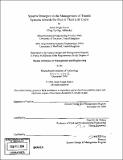| dc.contributor.advisor | Nigel H.M. Wilson. | en_US |
| dc.contributor.author | Kairon, Ajmer Singh | en_US |
| dc.contributor.other | System Design and Management Program. | en_US |
| dc.date.accessioned | 2008-09-03T15:27:06Z | |
| dc.date.available | 2008-09-03T15:27:06Z | |
| dc.date.copyright | 2006 | en_US |
| dc.date.issued | 2007 | en_US |
| dc.identifier.uri | http://hdl.handle.net/1721.1/42364 | |
| dc.description | Thesis (S.M.)--Massachusetts Institute of Technology, System Design and Management Program, February 2007. | en_US |
| dc.description | Includes bibliographical references (leaves 95-97). | en_US |
| dc.description.abstract | This thesis explores and evaluates essential strategies needed for the transit authority/operator to deal with end of life cycle challenges of Rapid Transit Systems (RTS) systems. RTS systems are elaborate systems consisting of various subsystems. It is believed that one of the greatest challenges of such systems is the integration of these various sub-systems to ensure that they work correctly; functionally and safely at the onset of development. While this is true there also exist real challenges towards the end of the life cycle which unfortunately is not dealt with during the design conceptualization and implementation. The fact that the RTS system is an elaborate amalgamation of other subsystems functioning together makes the management of its end of life cycle challenging. The life spans of these various subsystems are different i.e. the mismatch in life cycles of these systems could cause serious problems in the future. There are two approaches to manage these challenges i.e. look at it from a design standpoint and start incorporating fixes at the design stage to address end of life cycle challenges (start of the value chain) or look at the already present RTS systems around the world and see what can be done when most of the systems are mid life or nearing end of life and formulate strategies to address these challenges (end of the value chain). This thesis has focused on the latter approach given that systems at mid-life and near end of life are of priority now and further any lessons learnt from these exercises could be incorporated into new designs. Four different strategies were defined and assessed: Public Private Partnerships (PPP), reusability/remanufacturing/ recycling, life extension and leasing. In planning of the end of life cycle challenges it must be acknowledged that no one strategy is always best. | en_US |
| dc.description.abstract | (cont.) The strategies at most allow the transit authority/operator to make more meaningful and informed decisions based on risk and cost amongst many other factors. This allows a transit authority/operator to plan ahead. The transit authority/operator should look at their RTS system and evaluate the best strategy. It may be the case that one of these strategies meets their needs or a hybrid of these strategies | en_US |
| dc.description.statementofresponsibility | by Ajmer Singh Kairon. | en_US |
| dc.format.extent | 109 leaves | en_US |
| dc.language.iso | eng | en_US |
| dc.publisher | Massachusetts Institute of Technology | en_US |
| dc.rights | M.I.T. theses are protected by
copyright. They may be viewed from this source for any purpose, but
reproduction or distribution in any format is prohibited without written
permission. See provided URL for inquiries about permission. | en_US |
| dc.rights.uri | http://dspace.mit.edu/handle/1721.1/7582 | en_US |
| dc.subject | System Design and Management Program. | en_US |
| dc.title | System strategies in the management of transit systems towards the end of their life cycle | en_US |
| dc.type | Thesis | en_US |
| dc.description.degree | S.M. | en_US |
| dc.contributor.department | System Design and Management Program. | en_US |
| dc.identifier.oclc | 234314443 | en_US |
